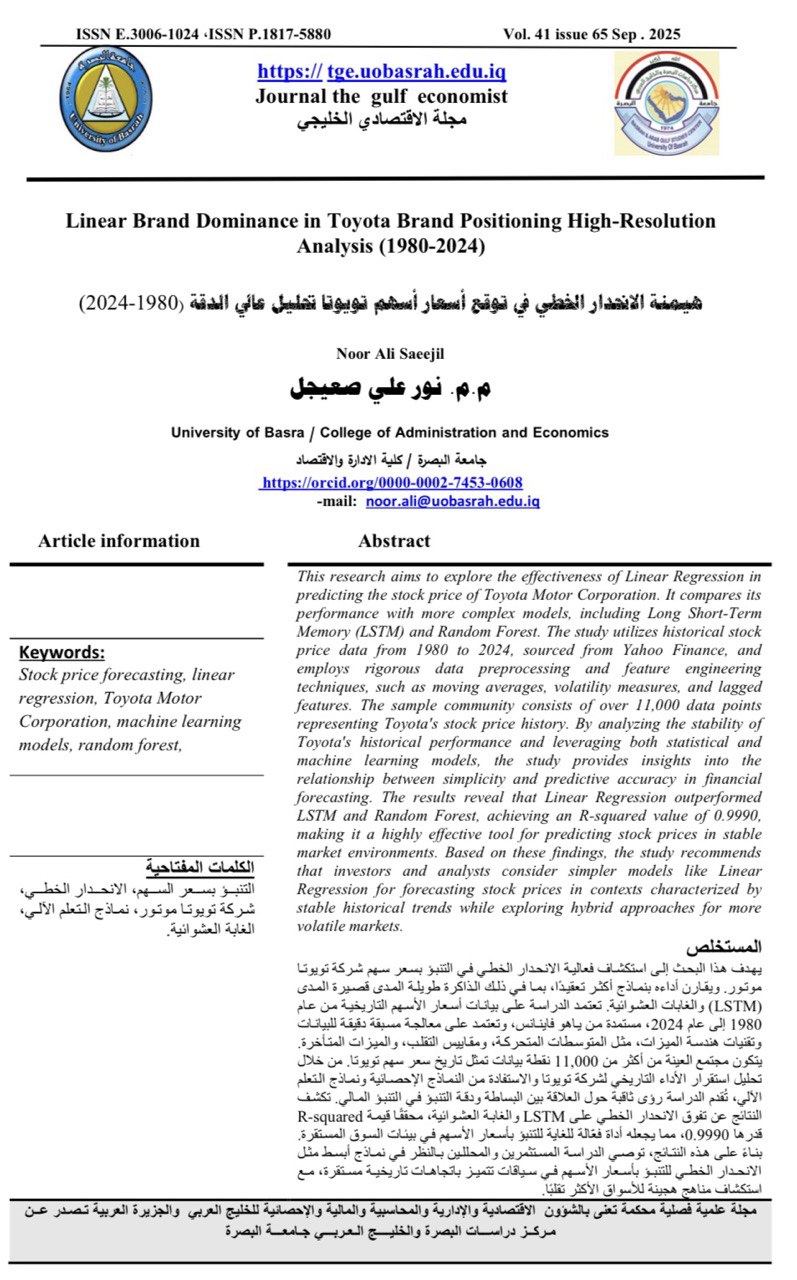Linear Brand Dominance in Toyota Brand Positioning High-Resolution Analysis (1980-2024)
Main Article Content
Abstract
This research aims to explore the effectiveness of Linear Regression in predicting the stock price of Toyota Motor Corporation. It compares its performance with more complex models, including Long Short-Term Memory (LSTM) and Random Forest. The study utilizes historical stock price data from 1980 to 2024, sourced from Yahoo Finance, and employs rigorous data preprocessing and feature engineering techniques, such as moving averages, volatility measures, and lagged features. The sample community consists of over 11,000 data points representing Toyota's stock price history. By analyzing the stability of Toyota's historical performance and leveraging both statistical and machine learning models, the study provides insights into the relationship between simplicity and predictive accuracy in financial forecasting. The results reveal that Linear Regression outperformed LSTM and Random Forest, achieving an R-squared value of 0.9990, making it a highly effective tool for predicting stock prices in stable market environments. Based on these findings, the study recommends that investors and analysts consider simpler models like Linear Regression for forecasting stock prices in contexts characterized by stable historical trends while exploring hybrid approaches for more volatile markets.
Article Details

This work is licensed under a Creative Commons Attribution-ShareAlike 4.0 International License.
References
Reference
- Ahmed, S. F., Alam, Md. S. B., Hassan, M., Rozbu, M. R., Ishtiak, T., Rafa, N., Mofijur, M., Shawkat Ali, A. B. M., & Gandomi, A. H. (2023). Deep learning modelling techniques: Current progress, applications, advantages, and challenges. Artificial Intelligence Review, 56(11), 13521–13617. https://doi.org/10.1007/s10462-023-10466-8
-Chen, M., Challita, U., Saad, W., Yin, C., & Debbah, M. (2019). Artificial Neural Networks-Based Machine Learning for Wireless Networks: A Tutorial. IEEE Communications Surveys & Tutorials, 21(4), 3039–3071. IEEE Communications Surveys & Tutorials. https://doi.org/10.1109/COMST.2019.2926625
-Dama, F., & Sinoquet, C. (2021). Time Series Analysis and Modeling to Forecast: A Survey (arXiv:2104.00164). arXiv. https://doi.org/10.48550/arXiv.2104.00164
-Gupta, I., Mittal, H., Rikhari, D., & Singh, A. K. (2022). MLRM: A Multiple Linear Regression based Model for Average Temperature Prediction of A Day (arXiv:2203.05835). arXiv. https://doi.org/10.48550/arXiv.2203.05835
-Lindemann, B., Müller, T., Vietz, H., Jazdi, N., & Weyrich, M. (2021). A survey on long short-term memory networks for time series prediction. Procedia CIRP, 99, 650–655. https://doi.org/10.1016/j.procir.2021.03.088
-Liu, S., Wu, K., Jiang, C., Huang, B., & Ma, D. (2023). Financial Time-Series Forecasting: Towards Synergizing Performance And Interpretability Within a Hybrid Machine Learning Approach (arXiv:2401.00534). arXiv. https://doi.org/10.48550/arXiv.2401.00534
-Rodríguez-Pérez, R., & Bajorath, J. (2022). Evolution of Support Vector Machine and Regression Modeling in Chemoinformatics and Drug Discovery. Journal of Computer-Aided Molecular Design, 36(5), 355–362. https://doi.org/10.1007/s10822-022-00442-9
-Soegianto, L. M., Hinandra, A. T., Suri, P. A., & Fajar, M. (2024). Comparison of Model Performance on Housing Business Using Linear Regression, Random Forest Regressor, SVR, and Neural Network. Procedia Computer Science, 245, 1139–1145. https://doi.org/10.1016/j.procs.2024.10.343
-Zou, J., Lou, J., Wang, B., & Liu, S. (2023). A Novel Deep Reinforcement Learning Based Automated Stock Trading System Using Cascaded LSTM Networks (arXiv:2212.02721). arXiv. https://doi.org/10.48550/arXiv.2212.02721
